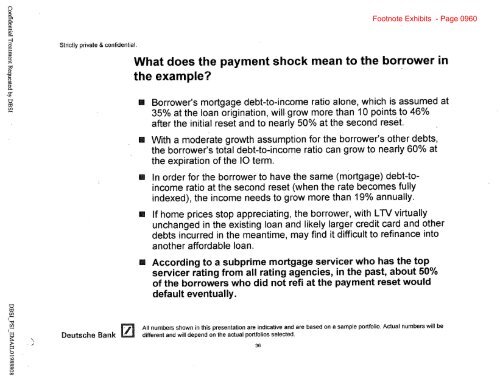2007_Subprime_Shorting-Home-Equity-Mezzanine-Tranches-1
2007_Subprime_Shorting-Home-Equity-Mezzanine-Tranches-1
2007_Subprime_Shorting-Home-Equity-Mezzanine-Tranches-1
You also want an ePaper? Increase the reach of your titles
YUMPU automatically turns print PDFs into web optimized ePapers that Google loves.
Footnote Exhibits - Page 0960<br />
Strictly private & confidential.<br />
What does the payment shock mean to the borrower in<br />
the example?<br />
U<br />
Borrower's mortgage debt-to-income ratio alone, which is assumed at<br />
35% at the loan origination, will grow more than 10 points to 46%<br />
after the initial reset and to nearly 50% at the second reset.<br />
M With a moderate growth assumption for the borrower's other debts,<br />
the borrower's total debt-to-income ratio can grow to nearly 60% at<br />
the expiration of the 10 term.<br />
E In order for the borrower to have the same (mortgage) debt-toincome<br />
ratio at the second reset (when the rate becomes fully<br />
indexed), the income needs to grow more than 19% annually.<br />
E If home prices stop appreciating, the borrower, with LTV virtually<br />
unchanged in the existing loan and likely larger credit card and other<br />
debts incurred in the meantime, may find it difficult to refinance into<br />
another affordable loan.<br />
M According to a subprime mortgage servicer who has the top<br />
servicer rating from all rating agencies, in the past, about 50%<br />
of the borrowers who did not refi at the payment reset would<br />
default eventually.<br />
Deutsche Bank<br />
All numbers shown in this presentation are indicative and are based on a sample portfolio. Actual numbers will be<br />
different and will depend on the actual portfolios selected.<br />
36<br />
00<br />
00 00<br />
00



